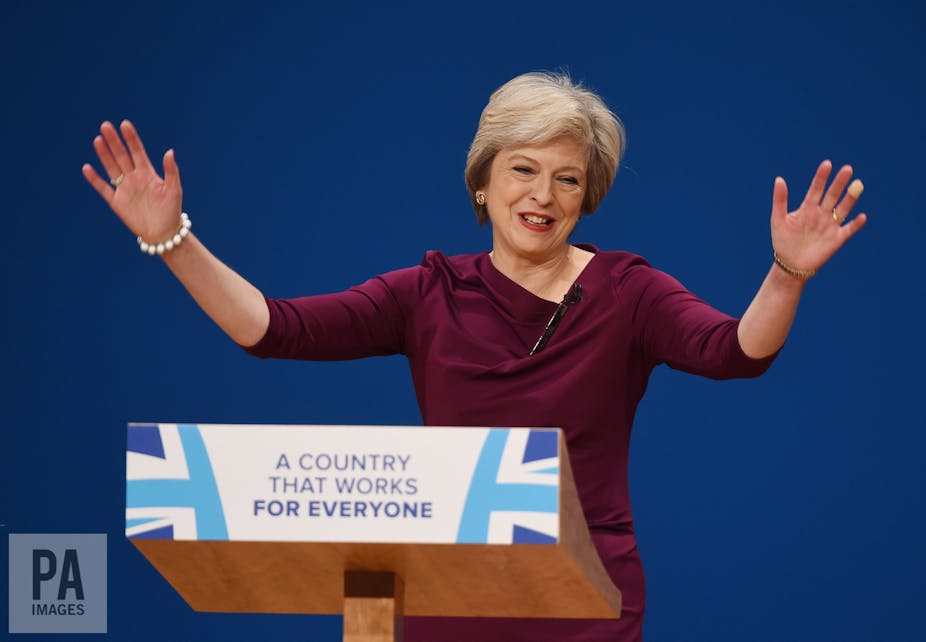Theresa May made some very welcome commitments to fairness in her speech to close her first party conference as prime minister. She pledged to tackle “unfairness and injustice”, “shifting the balance of Britain decisively in favour of ordinary working class people”.
In a speech almost entirely centred around this theme, May noted that it was working class families, not the wealthy “who made the biggest sacrifices after the financial crash”.
So far as she went, May’s analysis was on the button. While unemployment didn’t increase as much as expected in the most recent recession, a substantial fall in real wages was recorded. The lowest paid were hit particularly hard, while wage inequality grew. Young people were consistently most affected by falling wages, income and wealth.
Meanwhile, a number of social mobility indicators deteriorated since 2010, including low birth weight and school readiness. White working class children, particularly boys, are consistently underachieving compared to boys from other ethnic backgrounds.
May also spoke of an “economic and cultural revival of all of our great regional cities”, hinting at the divide between London and the north of England. Not only has London shown a faster economic recovery from the recent recession compared to the northern regions but gaps in some social outcomes also show signs of widening.
A higher proportion of children living in London are now achieving “good development”. London’s residents are also better qualified and have seen bigger health improvements in terms of the prevention of killer diseases, better mental health and fewer suicides. A smaller proportion of elderly people are disabled. Post-Brexit talk of a new industrial strategy to bring greater economic prosperity to struggling regions is therefore very welcome.
A daunting task
But if May really intends to lead in the spirit of social justice, she will need to go substantially further than she has so far.
Her remarks have clearly been aimed at the “hard working families” and prospective home owners who have become target voters for the Conservatives. But what about those in more marginal positions - people on the lowest incomes, or the most vulnerable and marginalised groups such as homeless people and refugees and asylum seekers?

Granted, she could not say everything in a short speech. But history suggests that if her redistributive focus continues to be on the working not-exactly-poor, following the example of David Cameron’s government, she will find it difficult to “make Britain a country that works for everyone”.
Analysis by the Centre for Analysis of Social Exclusion shows that despite pledges to protect the poor from the worst impacts of the financial crisis, it was the poorest quarter of households who were net losers from the combined tax and benefit changes brought in by the coalition government. The bottom 5% of households lost the most. Child poverty is now rising, up in 2014-15 from 17% to 19%.
The poorest households benefited very little from being let off income tax under the coalition because so much of their income was clawed back from the government in benefits cuts. The main gainers from the changes to the income tax personal allowance were households around the middle of the income distribution, while the main gainers of all changes to taxes and benefits taken together were about three-quarters of the way up. Cuts in benefits effectively paid for cuts in taxes for the better-off.
Our research also documented other limitations of the Cameron government’s social justice policies. Around 40% of Sure Start centres for young children have closed. Social care caseloads fell 25% as local government spending was slashed. And that while health budgets have been protected, they have not been increased in line with need, leading to visible strains in service provision. The number of adult learners fell 17% and the number of mature and part-time students in higher education nearly halved.
Central government funding for the regeneration of the most deprived neighbourhoods has been almost entirely cut, as has support for local charities and community work (between 50% and 100% in some deprived areas). Housing policies made little impact on the supply side of the new homes - between 2010 and 2014, only 140,000 new homes were completed per year, fewer than under Labour.
So tackling burning injustices and making Britain “a country that works for everyone” is going to require much bolder policies from the new prime minister than her predecessor enacted or she has signalled to date. She must have the least advantaged, not the middle group, as their target. It would be remarkable, but incredibly welcome, if we were to see this from a Conservative government.

